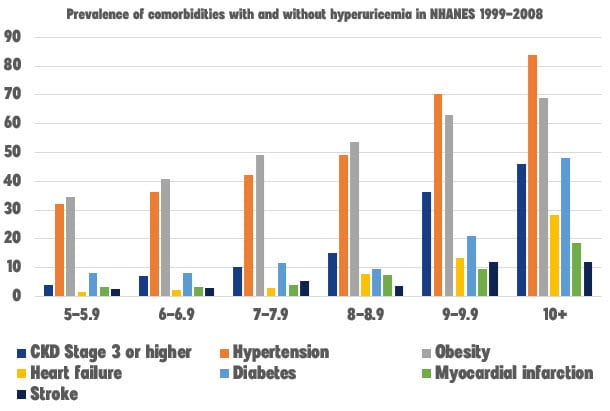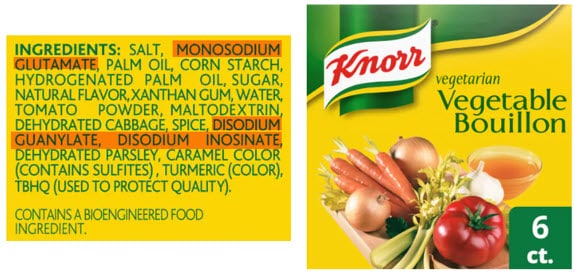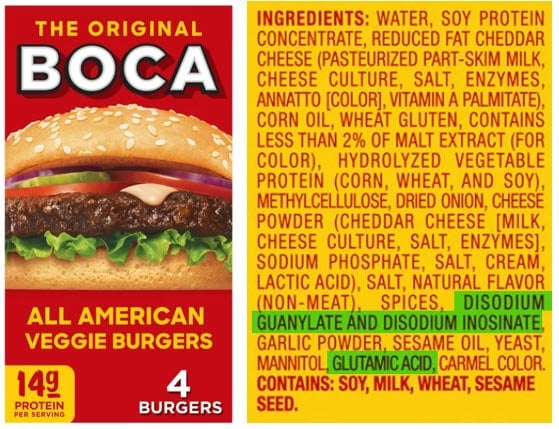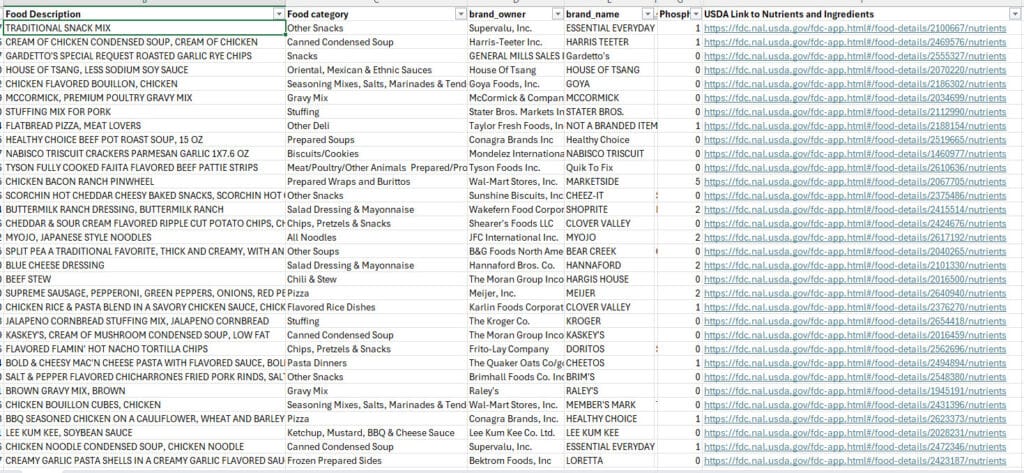Gout is a very common condition in people with CKD, and there are several nutritional factors that play a role. One nutritional factor that does not always get much attention is monosodium glutamate (MSG).
This post may contain affiliate links through which we may earn a small commission to help keep this website free.
What is gout?
Gout is a condition that is sometimes also called monosodium urate crystal deposition disease. It occurs when crystals deposit in tissues and become inflamed. These inflamed crystals lead to the pain and swelling that people experience during a gout flare or attack.
Gout flares often start at night and often first affect the big toe. However, crystals can also deposit in other joints such as your ankle, instep of your foot, wrist, fingers, elbows, hips, and even your back. The longer you’ve had gout, the higher risk you have of developing gout in additional locations of your body.
A key driver of gout is uric acid levels in your blood. The higher your uric acid levels, the higher your chances of forming crystals in your joints.
Does Gout lead to CKD?
For every 1mg/dL increase in uric acid levels, one study found that the risk of developing kidney disease increased 7%. Additionally, elevated uric acid levels are associated with a number of other conditions including hypertension, obesity, heart failure, diabetes, heart attack, and stroke.

You can see in the chart above (adapted from this study) that the higher the uric acid level, the more common these other conditions become – including kidney disease!
Uric acid crystals can deposit in tissue similar to how they deposit in joints. This was once referred to as gouty nephropathy, but is now called Chronic Urate Nephropathy. The crystals in the kidneys can lead to inflammation which causes fibrosis and scarring of the kidneys that can ultimately lead to CKD.
Elevated uric acid levels also increase your risk of developing acute kidney injury following the use of contrast dyes according to the research.
Although there is compelling evidence that uric acid contributes to the development of kidney disease, CKD can also cause uric acid levels to be higher. Uric acid is normally removed by the body via the kidneys and urine. When kidney function goes down, uric acid can build up in the blood.
MSG and Gout
There are several dietary strategies to help lower uric acid and prevent gout flares. One nutrition strategy that does not always get a lot of attention is limiting intake of monosodium glutamate, often abbreviated to MSG.
What is MSG?
MSG stands for monosodium glutamate. It’s a flavor enhancer commonly used in cooking, especially in Asian cuisine, but is also found in many non-Asian cuisine processed foods. MSG is derived from glutamic acid, an amino acid found naturally in various foods such as tomatoes, cheese, and mushrooms. It’s often added to foods to enhance their savory taste, known as umami.
Does MSG increase uric acid?
MSG has the potential to stimulate production of uric acid in the body, however the biggest increases in uric acid will come when MSG is combined with certain taste enhancers such as disodium inosinate (also known as inosine monophosphate or IMP) or disodium guanylate (also known as guanosine monophosphate), which are both purines. Both of these compounds have been shown to increase uric acid levels. A study of mice fed MSG (both with and without the addition of IMP) found that the combination of MSG with IMP accelerated the development of metabolic syndrome.
Below are some examples of foods containing MSG along with these taste enhancers that are known to generate uric acid:


Other ingredients that can act like MSG
The free glutamates in MSG are what contribute to the production of uric acid. There are many other ingredients that are also high in free glutamates and may be used in foods instead of MSG. These would be expected to have similar effects on the body as MSG:
- Glutamic acid
- Glutamate
- Monopotassium glutamate
- Calcium glutamate
- Monoammonium glutamate
- Magnesium glutamate
- Natrium glutamate
- Hydrolysed protein
- Calcium caseinate
- Sodium caseinate
- Yeast extract
- Torula yeast
- Yeast food
- Yeast nutrient
- Autolyzed yeast
- Gelatin
- Textured protein
- Whey protein and other related products
- Soy protein and other products
- Fortified protein
- Fermented foods
- Protease
- Vetsin
- Ajinomoto
- Umami
Below is an example of a food with an alternative to MSG, along with the taste enhancers:

Is MSG safe for kidney disease?
Although MSG is considered “safe” to add to foods, it does not mean that it is good for your health.
Some individuals are particularly sensitive to MSG and may develop reactions to MSG that can include headaches, nausea, diarrhea, irritable bowel syndrome, asthma attacks, and panic attacks.
Several studies have linked MSG to weight gain and obesity. One reason that MSG may cause excessive weight gain is by inducing leptin resistance. Leptin is a hormone that helps tell your brain that you are full and do not need to keep eating. People who are obese typically have high levels of leptin in their body, but their brain does not respond to the leptin, which means they are leptin resistant.
Leptin resistance can be problematic in people with kidney disease for a variety of reasons. Many foods that contain MSG are high in sodium and contain phosphorus additives. Overeating these foods (which is what MSG encourages you to do) will result in people eating too much sodium and phosphate.
Many people with kidney disease also have diabetes, and controlling diabetes is one of the best things that someone can do to help slow down progression of kidney disease. If MSG promotes overeating, this can make it more difficult to control blood sugars.
MSG has also been found to induce insulin resistance, which can make it even harder to control blood sugars in individuals who have diabetes and CKD. The development of insulin resistance and weight gain occurred even faster when MSG was combined with IMP.
What kinds of foods contain MSG and MSG taste enhancers?
Certain categories of foods like Chinese food, bouillon, and chips commonly have MSG and MSG enhancers added to them. However there are a wide variety of foods that have these ingredients. Below is a a screenshot of a list of foods containing disodium inosinate ingredients according to the USDA Branded Foods Database. The complete list contains almost 9,000 foods (which is too many to list here! But the full list is included with our Kidney Foodie Academy webinar on gout).

Summary
Monosodium glutamate, especially when combined with ingredients such as disodium guanylate and disodium inosinate, raises uric acid levels. Excessive consumption of MSG can also lead to excessive weight gain, leptin resistance, and insulin resistance.
Individuals with high uric acid levels or gout should avoid foods that contain MSG and disodium guanylate or disodium inosinate.
To learn more about strategies for controlling uric acid and preventing gout, join our Kidney Foodie Academy
